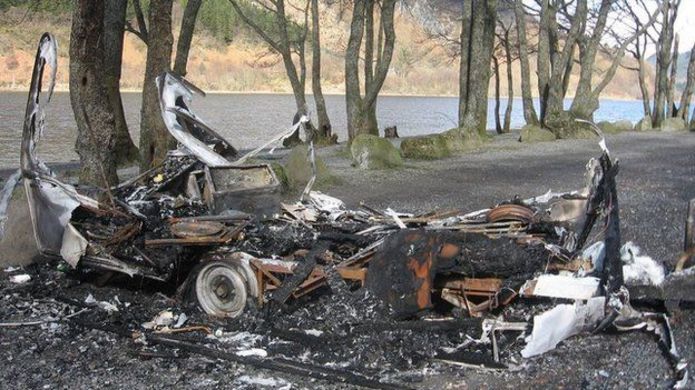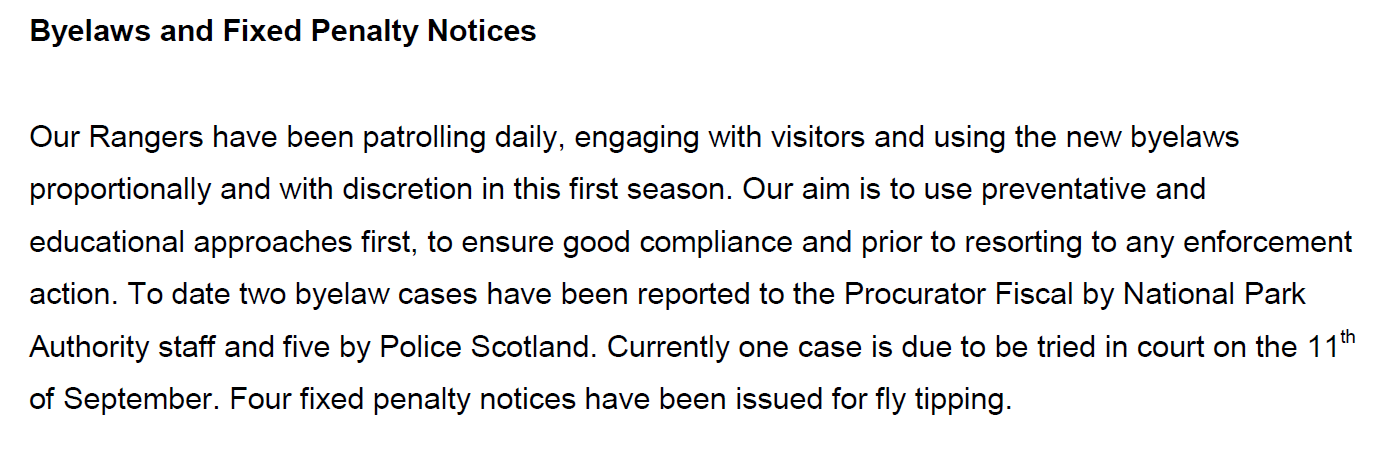
Last week, in a welcome development, some of the mainstream media picked up on the Loch Lomond and Trossachs National Park Authority first annual review of the camping byelaws for Scottish Ministers (see here). Unfortunately neither article picked up on the burnt out caravans, the fact that the National Park is no longer trying to enforce the byelaws against either caravans or campervans or the lack of any proper explanation of this in the report for Roseanna Cunningham, Cabinet Secretary for the Environment.
The focus of the BBC coverage (see here) and to a lesser extent the coverage in the National (see here) was on the hundreds of people warned for breaching the byelaws, 828 to be precise. The actual number of people unwittingly committing a criminal offence for breaching the byelaws is likely to be far higher, taking account of cases where no warning was given, but the fact that the LLTNPA is issuing large numbers of warnings should raise alarm bells with Scottish Ministers about how the Park Authority is being governed and about civil liberties.
Who approved the warning system?
On the governance side, there is no provision within the byelaws themselves to issue warnings. What’s more, in the Engagement and Enforcement Policy approved by the Board Engagement-and-Enforcement-Policy there is not a mention of any warning system being introduced. That policy refers to a “Loch Lomond & The Trossachs Camping Management Byelaws 2017 Enforcement procedures and principles” which I can find no evidence of having been approved by a Board Meeting and is NOT publicly available on the LLTNPA website. If this is right, the whole warning system has either been agreed in secret by the Board or else introduced by staff without Board approval. This raises some fundamental question about the legitimacy and lawful authority of the whole warning system. Do staff really have delegated authorities to approve such systems?
The warning system and civil liberties
The civil liberties issues are profound. The LLTNPA would appear to be keeping information on people who it believes have breached the byelaws but have decided not to refer to the Procurator Fiscal. Among the more obvious questions this raises are:
- On whose authority are LLTNPA staff holding such data as this has never been put to the Board for approval?
- Who are LLTNPA staff sharing this information with? For example, they appear to be sharing this data with the police – because the 828 figure includes warnings by both police and park rangers – but do they also share this information with others such as the Forestry Commission Rangers?
- What are the consequences of a warning? For example, if you have been issued with a warning and then camp again without a permit is referral to the Procurator Fiscal automatic?
- If being issued with a warning has consequences, how long is the LLTNPA holding this information on file? One year, five, ten years, indefinitely?
- What information is the LLTNPA and police handing out to people issued warnings about their rights? For example, are people being told they have the right to see the information that the Park hold on them and what if any right do people have to appeal about receiving a warning?
Given all these important issues, its interesting that in the report to the September Board Meeting which contained a report on how the byelaws had gone until that date there was not a mention of any warnings being issued:

Why?
The LLTNPA has also failed to explain how all these warning fit with “positive feedback” which Gordon Watson, the Park Chief Executive, claimed to have received in the National:
“From the positive feedback we’ve gathered through the visitor survey, to what our rangers have experienced by talking to campers on the ground during the first season, we are really pleased with how things have gone.
“The approach of our ranger service is always engagement and education first, with enforcement action only being taken as a last resort. That approach has worked well, with the vast majority of campers choosing to adhere to the by-laws.
“While warnings were issued, the number was small in proportion to the overall number of visitors and only a very small number of people were then reported to the procurator fiscal.”
So, Mr Watson, what feedback did you receive from all the people issued warnings? Or did you fail to ask them, just like you failed to mention anything about the complaints that have been received about the application of the byelaws in your Report to Roseanna Cunningham, Minister for the Environment?
What needs to happen
Unfortunately poor campers, as a friend observed, have no lawyers to challenge the Park about this legally (with cuts in legal aid not helping). Meantime various civil liberties and human rights organisations in Scotland have so far taken very little interest in the implications of the camping byelaws. Its time people interested in protecting people’s rights started to question the camping byelaws.
Meantime, the LLTNPA needs to provide answers as to who agreed to introduce the warning system, on what authority and what measures they have put in place to protect civil liberties.

As we approach the 15th anniversary of the passage of the Land Reform (Scotland) Act 2003 it is worth reflecting, to Scotland’s eternal shame, what is happening on the bonnie, bonnie banks of Loch Lomond and elsewhere in this national park. Nobody associated with this legislation, which secured our right to roam, ever anticipated that it would result in the sort of thuggery now been practised against campers by this National Park Authority. Threatening over 800 campers with criminal prosecution, despite their compliance with the Scottish Outdoor Access Code, is worse than a byegone era when landowners were able to use the Trespass Scotland (Act ) 1865 to intimidate campers. Did we elect a Scottish Government to take us back to Victorian times?
Photographs of burnt out caravans and fly tipping in media reports are nothing to do with camping. There is perfectly adequate legislation already in place to deal with such vandalism, if only the Park Authority and Police Scotland would get off their backsides and use it, instead of deliberately persuading gullible politicians that the answer lies in criminalising innocent campers.
There is plenty of publicly owned land in this national park where camping needs can be met through the provision of simple facilities. It is managed by Forestry Commission Scotland. Unfortunately the Commission’s senior management is more interested in doing secret deals with landowners, as exemplified in 2014 by their use of public funds, in excess of £7 million, to purchase Caledonian Forest land on Rothiemurchus Estate in the Cairngorms. There was no threat to that forest and no explanation of why public funds needed to be spent in this way. Meanwhile FCS claims it has zero funds available to provide for camping in the Loch Lomond and Trossachs National Park and colludes with the Park Authority in efforts to prohibit all camping near roadsides throughout Scotland.
It is obvious that this shambles around Loch Lomond and elsewhere is not going to be sorted out by the relevant Cabinet Secretaries, Fergus Ewing and Roseanna Cunningham. It is time for the First Minister to step in and demonstrate that her government is committed to upholding the principles of Scotland’s right to roam legislation and end the public body incompetence and massive waste of public money taking place in this national park. Furthermore, for a politician supposedly committed to upholding human rights, the intimidation of innocent, responsible campers is at risk of providing Nicola Sturgeon with a legacy worse that Margaret Thatcher’s poll tax.
There’s a surprise – it would appear from the info above that the majority of those being reported to the Fiscal under the bye-laws are actually receiving fly-tipping penalties in the end. Is that a fair interpretation?
This would seem to back up the strong arguments that there was plenty legislation in place to deal with irresponsible behaviour already and no bye-laws were necessary.
So, pre bye-laws the LLTNPA and police did not have the resources to clamp down on irresponsible behaviour such as fly tipping and Breach of the Peace, but suddenly they have plenty resources to devote to giving warnings and reporting folk to the Fiscal. Do we know if either body was given extra resources specifically to police the new bye-laws?
Mike, the four people fixed penalty notices for camping related “fly tipping” are separate from the ten cases referred to the PF but your conclusion and final question are spot on. The Park failed to take up the legal powers they had been given under the Regulatory Reform (Scotland) Act 2014 which amended the Environmental Protection Act 1990 to give them the power to issue fixed penalty notices (FPNs) for flytipping under section 33(1) and littering under section 87 of the Environmental Protection Act 1990. They have thus had almost three years where they had powers to take action against people littering but only got round to agreeing to use those powers in 2016 and only apparently started to use them this year. Given that perhaps the main justifications for the camping byelaws was the claim that litter left by campers was the major problem facing the National Park, any reasonable person might have thought they would have tried out their new litter powers BEFORE pushing for camping byelaws that removed the rights of responsible campers. They never did this and the fact there they report only 4 Fixed Penalty Notices for this year suggests that stopping litter is actually not what was this was all about. The offence under the byelaws is simply for being this though this now only applies to campers, not campervanners and caravanners. A further confusion is that while the Board Report refers to camping related flytipping offences, fly tipping and littering are different offences with different fixed penalties (£200 and £80 respectively) under the Act and its not clear campers were guilty of fly tipping as opposed to littering.
One thing that strikes me about the new draft strategic plan for LLTNPA, wrt camping/motorhomes and the bylaws, is that the language used seems to imply that the preference is to encourage private provision of services in this area – and that the bylaws (and camping management zones/permit system) are primarily a way to support and encourage this. In fact if you considered the plan from this perspective then other areas that repeatedly promote “Partnership Plans” could be considered in the same vein.
So whilst the draft plan makes dubious assertions like this “The well-established Loch Lomond Byelaws continue to work effectively, helping our Ranger Service to achieve balanced management of the lochs in a way that enables a wide range
of recreational activities, while minimising conflicts.” it then goes to make the LLTNPA’s intent a little clearer with this statement “This approach has achieved transformational improvements to East Loch Lomond and parts of The Trossachs through the 5 Lochs Visitor Management Plan. Continuing to find solutions which prevent these problems will support the more sustainable use of busy sites and give confidence for the private sector to play a role in providing visitor services.”
It’s that last part of the quote that particularly interests me. Is this the “balanced management” alluded to in the first quote?
I’m not suggesting whether private provision for camping/motorhomes is a good or bad thing – it’s probably about effective oversight – but if promoting private provision is the LLTNPA’s priority then its a little dishonest not to make this clear.